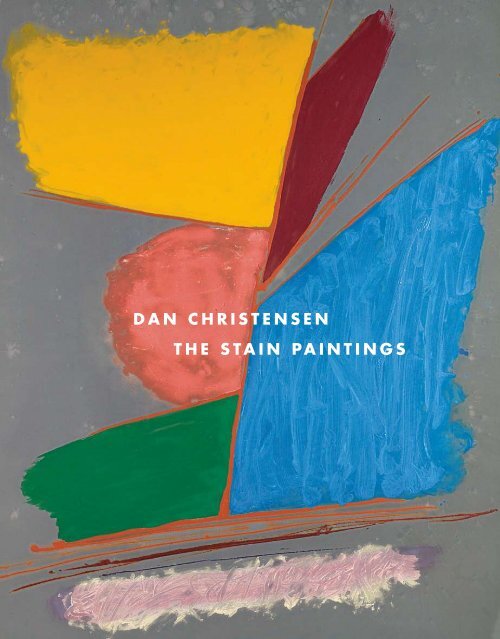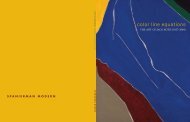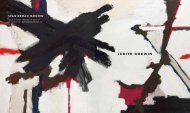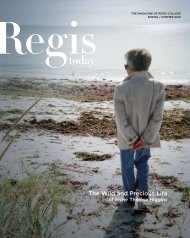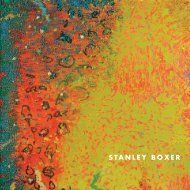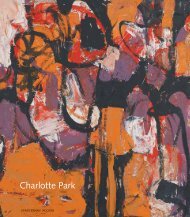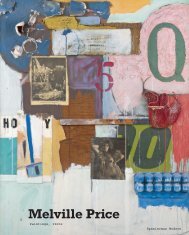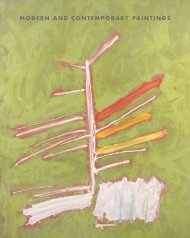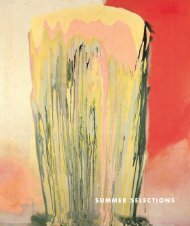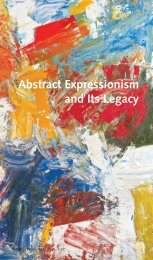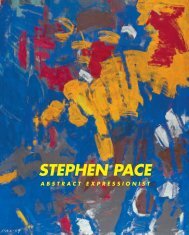Dan Christensen: The Stain Paintings - Spanierman Modern
Dan Christensen: The Stain Paintings - Spanierman Modern
Dan Christensen: The Stain Paintings - Spanierman Modern
Create successful ePaper yourself
Turn your PDF publications into a flip-book with our unique Google optimized e-Paper software.
d A n c h r i s t e n s e n<br />
the stAin pAintings<br />
A
dAn christensen<br />
the stAin pAintings, 1976–1988<br />
LisA n. peters<br />
feBruAry 8 to mArch 12, 2011<br />
spAniermAn modern<br />
53 eAst 58th street new york, ny 10022-1617 teL (212) 832-1400<br />
christineBerry@spAniermAn.com www.spAniermAnmodern.com<br />
1
Among coLor fieLd painters, <strong>Dan</strong> <strong>Christensen</strong><br />
(1942–2007) is best known for his pioneering<br />
use of the spray gun and the window-washing<br />
squeegee, from which he produced innovative and<br />
dynamic works with lustrous surface qualities. 1<br />
Less attention has been given to the paintings he<br />
created from 1976 to 1988, in which the staining<br />
of the canvas played a central role. As in his<br />
other works, in these images, <strong>Christensen</strong> explored<br />
many facets in the nature of painting, addressing<br />
issues he had considered earlier, while moving into<br />
new territory. Encompassing wide-ranging and<br />
innovative techniques, these color-soaked paintings,<br />
with their skeletal, skittish calligraphic lines<br />
and unusual harmonies of shape and tone, exude<br />
the artist’s pleasure and passion in the act of painting<br />
during a particularly joyous time in his life.<br />
<strong>Christensen</strong>’s usage of staining came about as a<br />
natural step in his logical progression, as he sought<br />
new ways to pursue the issues that compelled him.<br />
A similar development had occurred in his “plaid”<br />
paintings. 2 In these works of 1969–71, he turned<br />
from the spray gun to the use of commercial<br />
paint rollers and window-washing squeegees that<br />
he pulled or pushed across unstretched canvases<br />
that were stapled to a carpeted Xoor. Yet despite<br />
this new method and the contrast in appearance<br />
between the airy and luminous sprays and the<br />
tighter, more solid plaids, <strong>Christensen</strong> did not see<br />
a “drastic” change in his art. “<strong>The</strong> main diVerence,”<br />
he told the New York Times reporter Grace<br />
Glueck in 1971, “is that I’m working with more<br />
surface. I couldn’t get enough paint onto the<br />
canvas by spraying, or at least not the kind of paint<br />
I wanted.” 3<br />
<strong>Christensen</strong>’s turn to staining had a comparable<br />
genesis. <strong>The</strong> plaids had been followed by the<br />
white and dark “slab” paintings, some squeegeed<br />
or spread with masonry trowels, and others created<br />
with thick brushstrokes swirled into tactile<br />
layers of pigment, works in which <strong>Christensen</strong><br />
took advantage of new developments in acrylic<br />
paints that extended and thickened pigments.<br />
<strong>The</strong>se dense, manipulated, scraped surfaces seem<br />
the antithesis of the “stains,” in which paint and<br />
canvas are wedded, the canvas weave is part of the<br />
image, and colored shapes and lines seem to lithely<br />
graze the surface. Yet, in the artist’s exploration of<br />
the surface as a Weld for ongoing painting activity,<br />
this movement from thick to thinly bled pigment<br />
is less dramatic than it might appear from a visual<br />
comparison of the two groups of works. <strong>The</strong> paint<br />
extending agents <strong>Christensen</strong> employed in the<br />
slabs may have prompted him to consider and<br />
want to explore the opposite, the additives that<br />
could produce the eVect of dilution. Thus, rather<br />
than a reversal, the slab and stain paintings may<br />
be seen as two sides of the same coin.<br />
In fact, one link between these two groups is<br />
<strong>Christensen</strong>’s fascination with the possibilities of<br />
the new paints and painting products that came<br />
on the market, beginning in the 1960s. Whereas<br />
the Abstract Expressionists of an earlier generation<br />
had worked in oils thinned with turpentine, the<br />
younger generation had access to the new waterbased<br />
acrylics developed by Leonard Bocour and<br />
Sam Golden. <strong>The</strong>se included latex house paints<br />
and paints that could be thinned with water to the<br />
consistency of a watercolor wash without losing<br />
their color. <strong>The</strong> new paints spread easily, dried<br />
quickly, and left clean edges, by contrast with<br />
the blurring effects of thinned oils. Among the<br />
additives that <strong>Christensen</strong> favored was a tensionbreaker<br />
developed by Golden. A substance with<br />
the property of liquid detergent but without its<br />
viscosity, the tension breaker could be added to a<br />
water-based paint to reduce surface tension, allowing<br />
paint to disperse readily and penetrate into the<br />
canvas rather than laying on top of it. Unavailable<br />
when Helen Frankenthaler began to use staining<br />
methods in the early 1950s, this means of achieving<br />
liquidity was clearly one that <strong>Christensen</strong><br />
found rich in opportunities that he avidly pursued.<br />
As he had in the plaids, in the stains, <strong>Christensen</strong><br />
3
4<br />
Fig. 1.<br />
<strong>Dan</strong> <strong>Christensen</strong>, Studio,<br />
Waverly Place, New York,<br />
1981; photograph by<br />
Arthur Mones (1919–1998),<br />
Collection of the <strong>Dan</strong><br />
<strong>Christensen</strong> Marital Trust.<br />
began a work by stapling the unstretched canvas<br />
to the carpeted Xoor. Mixing his colors in cups<br />
or buckets, he would then pour the thinned paint<br />
onto the raw canvas and roll the paint uniformly<br />
to create an overall ground for the painting. He<br />
would sometimes lay multiple colors on top of<br />
each other to achieve the desired hue. <strong>The</strong> next<br />
step was the calligraphic “drawing,” or framework,<br />
of the piece. A stick, a brush, sometimes a turkey<br />
baster, would be the instrument of choice for this<br />
aspect of the painting. He would Wnish by pouring<br />
paint into areas around this framework where he<br />
wanted color, and he would then manipulate it<br />
with paint rollers, brushes, or basters. At times he<br />
left the color on the surface and at other times he<br />
let it bleed into the canvas. In a few instances, he<br />
would go over an area with a Wne gritted sandpaper<br />
to give a painting a textured look.<br />
While reXecting issues that would occupy<br />
<strong>Christensen</strong> throughout his career, the paintings<br />
in this show represent a unique convergence in<br />
his art, as he merged the Xatness that was a staple<br />
of Color Field painting with the tactility and gestural<br />
presence of action that had been a foundation<br />
of Abstract Expressionist painting. Although<br />
<strong>Christensen</strong> had been too young to take part in<br />
the Abstract Expressionist movement during its<br />
heyday, having moved to New York in 1965, he<br />
had absorbed a knowledge of the movement in his<br />
youth. When he was sixteen, he saw the work of<br />
Jackson Pollock on a trip to Denver, an experience<br />
that made him realize that “he could take<br />
a diVerent approach to art—that it was possible<br />
for painting to be a personal experience.” 4 His<br />
absorption of the art of his predecessors was noted<br />
by Valentin Tatransky in 1982. Reviewing a show<br />
consisting primarily of <strong>Christensen</strong>’s stains being<br />
held at Meredith Long Contemporary Gallery<br />
in New York, Tatransky acknowledged this early<br />
exposure, writing: “<strong>Dan</strong> <strong>Christensen</strong> is a painter<br />
who’s thought hard about Pollock, Newman,<br />
Olitski, and Noland, going through them rather<br />
than around them.” Referencing the paintings on<br />
view, Tatransky observed: “Other artists have also<br />
tried to break the pictorial canon of high abstract<br />
art in this way, and many of their results have<br />
been poor. What makes <strong>Christensen</strong> succeed is his<br />
sensitivity for surface. He’s especially good at laying<br />
down and layering washes of color, and so his fragile,<br />
brittle, tree-like images come as a surprise.” 5<br />
Despite the continuity in <strong>Christensen</strong>’s art from<br />
the slabs to the stains, one immediate diVerence<br />
is the emergence in his art of “Wgure-ground”<br />
relationships that he had previously suppressed.<br />
Yet, that this new “imagery” did not compromise<br />
the “cohesive eVect of all-overness,” was noted<br />
by John ElderWeld in the catalogue for New Work<br />
on Paper 1, a show he curated for the Museum of<br />
<strong>Modern</strong> Art in 1981, shortly after his arrival as<br />
chief curator at the museum. Among the eight<br />
artists included in the exhibition, <strong>Christensen</strong> was<br />
represented by eleven works in acrylic on paper<br />
that were similar to his stain paintings on canvas<br />
of the time. To ElderWeld, <strong>Christensen</strong> had kept<br />
the eVect uniWed because “the drawing that makes<br />
each picture frankly repeats the geometry of the<br />
whole surface—following its corners, its diagonals,
or dividing it down the center—as well as displacing<br />
that geometry at the same time.” ElderWeld<br />
observed the way that the color of <strong>Christensen</strong>’s<br />
drawing either stayed “quite close in tone to that<br />
of the ground or is a thin or whitened or otherwise<br />
‘light’ form of drawing that does not seem to<br />
cut into depth . . . because the drawing either lays<br />
candidly on top of the Xat surface (which seems,<br />
therefore, to pass uninterruptedly beneath it) or is<br />
embedded against the surface by accents and areas<br />
of color that form, as it were, an upper or overlayed<br />
surface.” In a review of the exhibition, Hilton<br />
Kramer also commended <strong>Christensen</strong>’s drawings,<br />
remarking how, for example, “a watercolor shape<br />
is made to ‘rhyme,’ so to speak, with a crayon line<br />
of similar color or hue.” 6 In a Newsweek article, in<br />
which he covered the show, John Ashbery noted<br />
that <strong>Christensen</strong>’s “lighter-than-air abstractions”<br />
evoked “tendrils held up to the light.” 7<br />
In the Museum of <strong>Modern</strong> Art’s catalogue<br />
ElderWeld gave credence to how the giving and<br />
taking of space across <strong>Christensen</strong>’s surfaces,<br />
whether frontal or open, gave his art coherence<br />
and stability. At the same time, ElderWeld observed<br />
that <strong>Christensen</strong>’s new work suggested certain<br />
organic allusions, writing: “Its very creation of<br />
geometry from gesture invites comparison with<br />
spontaneous natural growth, just as the particular<br />
structures thus formed invite comparison with<br />
speciWc fragments and forms of the natural world.”<br />
While recognizing that abstract art naturally<br />
“makes concessions to the appearance of things<br />
outside of itself,” ElderWeld noted that the associations<br />
to be drawn from <strong>Christensen</strong>’s works<br />
gave them their distinctive moods, which he felt<br />
were often pastoral, “telling of the instinctual, of<br />
the fragile as well as lush beauty, and above all of<br />
sensual delectation.” 8 Of the works <strong>Christensen</strong><br />
created between 1976 and 1984, the art historian<br />
James Monte also commented on the associative<br />
aspect of these paintings, stating: “A shaping of<br />
thickly painted color turns into a fantastic creature,<br />
in one instance a goggle-eyed amphibian<br />
emerging from a luminously painted ground.” 9<br />
At one point Monte even referred to these paintings<br />
as biomorphic abstractions, evoking the legacy<br />
of art of Joan Miró, for which <strong>Christensen</strong> had<br />
a deep reverence. 10 That <strong>Christensen</strong>’s new works<br />
struck the nerve of his time was reXected in the<br />
commission he received from Delmar Hendricks,<br />
the director of the Gallery at Lincoln Center and<br />
the head of its poster program, to create a poster<br />
for the Mostly Mozart Festival of 1980. <strong>Christensen</strong>’s<br />
serigraph, portraying minimal washes of color and<br />
line, was the Wrst, and possibly the only special<br />
edition print to sell out (Fig. 2).<br />
Although it may be a stretch to link the works<br />
of 1976 to 1987 directly with <strong>Christensen</strong>’s life,<br />
the years he created them encompass a period of<br />
particular happiness for him. Settled in New York,<br />
his divorce of the late 1960s behind him, in 1978,<br />
he married the actor and model Elaine Grove<br />
(now a sculptor). <strong>The</strong>ir son, Jimmy, was born in<br />
1979, and a second son, Willie, arrived in 1982.<br />
<strong>Christensen</strong>’s son from his Wrst marriage, Moses, a<br />
teenager then, was present for summer visits. <strong>The</strong><br />
period was one in which the family spent summers<br />
in the Springs, Long Island, near the homes<br />
of many like-minded abstract painters, enjoying<br />
a place to which they would move permanently<br />
in 2002. Among the artists who regularly came by<br />
<strong>Christensen</strong>’s studio in those days were the painters<br />
Larry Poons, Larry Zox, and Ronnie LandWeld,<br />
and the sculptors Michael Steiner and Peter<br />
Reginato. Jack Bush, Daryl Hughto, and Walter<br />
Fig. 2.<br />
Fine Arts Creations, Inc.,<br />
New York, poster after serigraph<br />
by <strong>Dan</strong> <strong>Christensen</strong><br />
for Mostly Mozart Festival,<br />
Avery Fisher Hall, Lincoln<br />
Center, July 14–August 23,<br />
1980, Collection of the <strong>Dan</strong><br />
<strong>Christensen</strong> Marital Trust.<br />
5
6<br />
Fig. 3.<br />
<strong>Dan</strong> <strong>Christensen</strong> in<br />
chest waders, Montauk,<br />
New York; photograph by<br />
Elaine Grove, Collection<br />
of the <strong>Dan</strong> <strong>Christensen</strong><br />
Marital Trust.<br />
Darby Bannard lived out of town, but would visit<br />
when they came to the city. At Max’s Kansas City,<br />
<strong>Christensen</strong> would see and spend time with Jules<br />
Olitski and Kenneth Noland. Times of friendship,<br />
these gatherings also provided opportunities<br />
for a spirited exchange of ideas that spurred the<br />
artists to venture in new directions in their work.<br />
<strong>The</strong> poet Billy Collins and the art historian Karen<br />
Wilkin also were in touch with <strong>Christensen</strong>, as<br />
was the noted critic Clement Greenberg, who had<br />
championed Post-Painterly Abstraction beginning<br />
in the early 1960s. 11 An admirer of <strong>Christensen</strong>’s<br />
work, Greenberg stated in 1990: “<strong>Dan</strong> <strong>Christensen</strong><br />
is one of the painters on whom the course of<br />
American art depends.” 12 Yet, as Grove recalls,<br />
“<strong>Dan</strong> liked Clem very much and had enormous<br />
respect for his eye, but he did not consider himself<br />
a strict Greenbergian formalist.”<br />
Despite the abstractness of <strong>Christensen</strong>’s art, his<br />
Long Island summers are suggested in many of<br />
the stains. While Atlantic Champagne (1979) evokes<br />
the frothiness of the drink in its title, it also references<br />
the sea, where <strong>Christensen</strong> spent time surf<br />
casting at the ocean’s edge. In other images such<br />
as Troubadour (1988), Sissystrut (1980), and Santali<br />
(1980), sails, Xags Xying, sea breezes, and coastal<br />
light seem to preside. <strong>Christensen</strong>’s enigmatic<br />
titles reference a number of sources. However, the<br />
artist would not be thinking of a literal title as he<br />
painted. Instead a title often simply occurred to<br />
him when he stood back from a completed work,<br />
or some aspect of a work would bring a title to<br />
mind. To express the idea of a separation between<br />
a title and a work, <strong>Christensen</strong> would at times<br />
slightly change the spelling of a word used in a<br />
title. <strong>The</strong> titles of <strong>Christensen</strong>’s paintings are best<br />
considered as reXective of his context, conveying<br />
the music he played in his studio or names from<br />
literature or Wlm that had drawn his attention. <strong>The</strong><br />
titles of works in the show include Beulah Land<br />
(1978), perhaps referencing the hymn of this name<br />
written in 1875 by Edgar Page Stiles, or an idyllic<br />
place looking over a heavenly vista as described in<br />
John Bunyan’s Pilgrim’s Progress. <strong>The</strong> title Sissystrut<br />
(1980) is drawn from the funk classic “Cissy Strut,”<br />
by the Meters, a New Orleans Band that launched<br />
the career of Art Neville. Jambo Caribe (1981) is<br />
the name of a 1964 song by Dizzy Gillespie, while<br />
Topsy Part II is the title of an R&B hit by Cozy<br />
Cole, famed for its prolonged drum solo. Song of<br />
Ceylon (1977) may reference the unusual 1934<br />
British documentary by John Grierson about<br />
native rituals in Sri Lanka.<br />
A number of works suggest <strong>Christensen</strong>’s<br />
response to the legacy of Abstract Expressionism.<br />
In Atlantic Champagne (1979), <strong>Christensen</strong> Xung,<br />
brushed, and pulled Pollock-like gestures of<br />
white paint of diVerent consistencies on a wallscale<br />
horizontal, but the cartoonish humor and<br />
scribbling suggests a pure pleasure in the movement<br />
of paint on this expanse rather than a sense<br />
of angst. A feeling of the light in Monet’s last<br />
paintings reverberates outward from this work.<br />
Monet, in fact, is an artist for which <strong>Christensen</strong><br />
felt a particular aYnity, while paintings in which<br />
<strong>Christensen</strong> created harmonies with vivid hues<br />
and a balance of asymmetrical forms such as Troubadour<br />
(1988) bring to mind his admiration for the<br />
art of Matisse, who <strong>Christensen</strong> noted as among<br />
his favorite artists in 1974. 13 In the shimmering<br />
Ridge (1976), <strong>Christensen</strong> poured silver under the<br />
semi-translucent white ridged backbone, bringing<br />
the light through from the back of this form.
It was works such as this to which the poet and<br />
critic John Ashbery referred in a review of an<br />
exhibition of <strong>Christensen</strong>’s art in 1979. In a day<br />
when artists had either taken the Minimal into the<br />
purely conceptual or had returned to representational<br />
forms of image-making, Ashbery found it<br />
“sobering and refreshing to turn to a number of<br />
artists who are extending the language of modernism<br />
in a more traditional and serious way.” He<br />
went on to note that “one younger artist who has<br />
renewed the tradition [of Color Field painting]<br />
honorably is <strong>Dan</strong> <strong>Christensen</strong>. His pale, vaporous<br />
washes of light are delectable. Often they are<br />
loosely organized along a white line which serves<br />
as an axis for vague blotches of color to relate to—<br />
sometimes like petals on a stem, or laundry on a<br />
clothesline, or clouds bisected by a telephone wire,<br />
though such comparisons are considered odious<br />
in discussions of this kind of work.” Ashbery<br />
found <strong>Christensen</strong>’s color occasionally “smoldering<br />
and sensuous,” but observed that the artist<br />
was “mainly interested in articulating the nuances<br />
separating patches of close-keyed dull pastel tones,<br />
and he does it masterfully. He forces the eye to<br />
recognize distinctions among areas of color which<br />
at Wrst have strong family resemblances and only<br />
somewhat later turn out to be mavericks who<br />
could just as easily be at odds with each other.”<br />
Referencing the universal metaphor of the Tree<br />
of Life, Ridge has an iconic quality, yet its freshness<br />
and simplicity make this work Wrst and foremost<br />
a sensuous optical experience, the product of an<br />
artist in love with the interaction of paint and<br />
surface and the inWnite ways of exploring their<br />
convergence.<br />
Lisa N. Peters<br />
1. Notable sources on <strong>Christensen</strong> include Sharon L.<br />
Kennedy, Douglas Drake, and Karen Wilkin, <strong>Dan</strong> <strong>Christensen</strong>:<br />
Forty Years of Painting, exh. cat. (Kansas City, Mo.: Kemper<br />
Museum of Contemporary Art, 2009); <strong>Dan</strong> <strong>Christensen</strong>: <strong>The</strong><br />
Plaid <strong>Paintings</strong>, exh. cat. (including an interview with<br />
Elaine Grove) (New York: <strong>Spanierman</strong> <strong>Modern</strong>, 2009); and<br />
Stephen Westfall, <strong>Dan</strong> <strong>Christensen</strong>, exh. cat. (New York:<br />
<strong>Spanierman</strong> <strong>Modern</strong>, 2007).<br />
2. <strong>The</strong>se paintings were the subject of <strong>Dan</strong> <strong>Christensen</strong>:<br />
<strong>The</strong> Plaid <strong>Paintings</strong> (2009).<br />
3. Grace Glueck, “A Happy New Year?” Art in America 59<br />
(January–February 1971), 27.<br />
4. Cited in Sharon L. Kennedy, “Charting His Course:<br />
<strong>Dan</strong> <strong>Christensen</strong>’s Early Years,” in Kennedy, Drake, and<br />
Wilkin, 2009, 10.<br />
5. Valentin Tatransky, “<strong>Dan</strong> <strong>Christensen</strong>,” Arts Magazine<br />
(May 1982), 11.<br />
6. Hilton Kramer, “Art: Show of New Works Sets<br />
Example at <strong>Modern</strong>,” New York Times, February 13, 1981.<br />
7. John Ashbery, “Pleasures of Paperwork,” Newsweek,<br />
March 16, 1981, 94.<br />
8. John ElderWeld, New Work on Paper 1, exh. cat.<br />
(New York: Museum of <strong>Modern</strong> Art, 1981), 12.<br />
9. James Monte, <strong>Dan</strong> <strong>Christensen</strong>: <strong>The</strong> Circular <strong>Paintings</strong>,<br />
exh. cat. (New York: Salander-O’Reilly Galleries, Inc., 1991).<br />
10. James Monte, “A Note on <strong>Dan</strong> <strong>Christensen</strong>’s<br />
<strong>Paintings</strong>,” in <strong>Dan</strong> <strong>Christensen</strong>: A Survey, 1966–1990, exh. cat.<br />
(East Hampton, N.Y.: Vered Gallery, 1990). See also Barbara<br />
Rose, Miró in America, exh. cat. (Houston, Tex.: Museum of<br />
Fine Arts, 1982).<br />
11. On this term and Greenberg’s conception of it, see<br />
Karen Wilkin, “Notes on Color Field Painting,” in Wilkin,<br />
Color as Field: American Painting, 1950–1975, exh. cat. (New<br />
York: American Federation of Arts in association with Yale<br />
University Press, New Haven, Conn., 2007), 11–75.<br />
12. Clement Greenberg’s statement appears in <strong>Dan</strong><br />
<strong>Christensen</strong>: A Survey, 1966–1990, exh. cat. (East Hampton,<br />
N.Y.: Vered Gallery, 1990).<br />
13. Unpublished typescript, “Interview with <strong>Dan</strong><br />
<strong>Christensen</strong> by R. Phillips and W. Hamilton,” November 2,<br />
1974, part 1, 2.<br />
7
8<br />
beulah land, 1978, AcryLic on cAnvAs, 29 1 ⁄ 8 x 68 3 ⁄ 4 in.
idge, 1976, AcryLic on cAnvAs, 78 x 90 1 ⁄ 2 i n .<br />
9
atlantic champagne, 1979, AcryLic on cAnvAs, 69 1 ⁄ 2 x 131 1 ⁄ 2 in.<br />
11
12<br />
polarstar, 1978, AcryLic And gesso on cAnvAs, 26 x 39 1 ⁄ 2 in.
song of ceylon, 1979, AcryLic on cAnvAs, 73 1 ⁄ 2 x 91 in.<br />
13
14<br />
norseland, 1979, AcryLic And gesso on cAnvAs, 43 x 63 in.
little ceasar, 1979, AcryLic on cAnvAs, 60 3 ⁄4 x 57 3 ⁄4 in.<br />
15
16<br />
infield seltzer, 1980, AcryLic on cAnvAs, 102 x 66 in.
ig bad wolf, 1981, AcryLic on cAnvAs, 43 1 ⁄ 4 x 69 in.<br />
17
18<br />
sissystrut, 1980, AcryLic on cAnvAs, 69 x 52 1 ⁄ 2 i n .
santali, 1980, AcryLic on cAnvAs, 66 3 ⁄ 4 x 6 2 i n .<br />
19
20<br />
coahoma, 1981, AcryLic on cAnvAs, 20 x 1 5 i n .
yellow bower, 1981, AcryLic on cAnvAs, 71 1 ⁄ 4 x 40 in.<br />
21
22<br />
carib cocktail, 1981, AcryLic on cAnvAs, 68 x 53 1 ⁄ 4 in.
topsy part ii, 1981, AcryLic on cAnvAs, 67 x 6 9 i n .<br />
23
24<br />
tokyo tattoo, 1981, AcryLic on cAnvAs, 87 x 77 7 ⁄ 8 in.
jambo caribe, 1981, AcryLic on cAnvAs, 64 x 5 2 i n .<br />
25
26<br />
troubadour, 1988, AcryLic on cAnvAs, 90 7 ⁄ 8 x 75 in.
checkList of the eXhiBition<br />
AtLAntic chAmpAgne 1979<br />
Acrylic on canvas, 69H 2 131H in.<br />
Signed, dated, and inscribed on verso:<br />
© D. <strong>Christensen</strong> 1979 “Atlantic Champagne”<br />
Inscribed on stretcher: 131H x 69H<br />
BeuLAh LAnd 1978<br />
Acrylic on canvas, 29J 2 68I in.<br />
Signed, dated, and inscribed on verso:<br />
© D. <strong>Christensen</strong> 1978 acrylic on canvas “Beulah Land”<br />
Inscribed on stretcher: 29G x 68I<br />
Big BAd woLf 1981<br />
Acrylic on canvas, 43G 2 69 in.<br />
Signed, dated, and inscribed on verso:<br />
© D. <strong>Christensen</strong> 1981 / “Big Bad Wolf”<br />
Inscribed on stretcher: 43H x 69<br />
cAriB cocktAiL 1981<br />
Acrylic on canvas, 68 2 53G in.<br />
Signed, dated, and inscribed on verso:<br />
acrylic on canvas © D. <strong>Christensen</strong> 1981 “Carib Cocktail”<br />
Inscribed on stretcher: 53G x 68<br />
coAhomA 1981<br />
Acrylic on canvas, 20 2 15 in.<br />
Signed, dated, and inscribed on verso:<br />
© D. <strong>Christensen</strong> 1981 / “Coahoma”<br />
infieLd seLtZer 1980<br />
Acrylic on canvas, 102 2 66 in.<br />
Signed, dated, and inscribed on verso:<br />
D. <strong>Christensen</strong> 1980 “Infield Seltzer” acrylic on canvas<br />
JAmBo cAriBe 1981<br />
Acrylic on canvas, 64 2 52 in.<br />
Signed, dated, and inscribed on verso: acrylic on<br />
canvas “Jambo Caribe” © D. <strong>Christensen</strong> 1981<br />
LittLe ceAsAr 1979<br />
Acrylic on canvas, 60I 2 57I in.<br />
Signed on verso: © D. <strong>Christensen</strong><br />
Inscribed on stretcher: “Little Ceasar” /<br />
(for Jimmy Lu) / 57I x 60I<br />
norseLAnd 1979<br />
Acrylic and gesso on canvas, 43 2 63 in.<br />
Signed, dated, and inscribed on verso:<br />
© D. <strong>Christensen</strong> 1979 “Norseland” acrylic &<br />
gesso on canvas / © D. <strong>Christensen</strong><br />
poLArstAr 1978<br />
Acrylic and gesso on canvas, 26 2 39H in.<br />
Signed, dated, and inscribed on verso: D. <strong>Christensen</strong> /<br />
“Polarstar” / 1978 / acrylic & gesso on canvas<br />
Inscribed on stretcher: 39H x 26<br />
ridge 1976<br />
Acrylic on canvas, 78 2 90H in.<br />
Signed, dated, and inscribed on verso:<br />
D. <strong>Christensen</strong> 1976 “Ridge” / 78 x 91<br />
sAntALi 1980<br />
Acrylic on canvas, 66I 2 62 in.<br />
Signed, dated, and inscribed on verso:<br />
© D. <strong>Christensen</strong> 1980 “Santali” acrylic on canvas<br />
sissystrut 1980<br />
Acrylic on canvas, 69 2 52H in.<br />
Signed and inscribed on verso:<br />
© D. <strong>Christensen</strong> “Sissystrut” acrylic on canvas<br />
Inscribed on stretcher: 69 x 52H<br />
song of ceyLon 1979<br />
Acrylic on canvas, 73H 2 91 in.<br />
Signed, dated, and inscribed on verso:<br />
D. <strong>Christensen</strong> 1979 “Song of Ceylon” acrylic on canvas<br />
tokyo tAttoo 1981<br />
Acrylic on canvas, 87 2 77M in.<br />
Signed, dated, and inscribed on verso:<br />
“Tokyo Tattoo” © D. <strong>Christensen</strong> 1981 acrylic on canvas<br />
Inscribed on stretcher: 77I x 87<br />
topsy pArt ii 1981<br />
Acrylic on canvas, 67 2 69 in.<br />
Signed, dated, and inscribed on verso:<br />
© D. <strong>Christensen</strong> 1981 / Topsy Part II<br />
trouBAdor 1988<br />
Acrylic on canvas, 90M 2 75 in.<br />
Signed, dated, and inscribed on verso:<br />
© D. <strong>Christensen</strong> 1988 “Troubadour”<br />
Inscribed on stretcher: 91 x 75<br />
yeLLow Bower 1981<br />
Acrylic on canvas, 71G x 40 in.<br />
Signed, dated, and inscribed on verso: acrylic<br />
on canvas / © D. <strong>Christensen</strong> 1981 “Yellow Bower”<br />
Inscribed on stretcher: 40 x 71G<br />
27
28<br />
dAn christensen<br />
b. 1942, Cozad, Nebraska<br />
d. 2007, Springs, East Hampton, New York<br />
1964, received B.F.A., Kansas City Art Institute<br />
s e L e c t e d s o L o e X h i B i t i o n s<br />
André Emmerich Gallery, New York, 1969, 1971,<br />
1972, 1974, 1975, 1976.<br />
Edmonton Art Gallery, Alberta, Canada, 1973.<br />
University of Nebraska at Omaha Art<br />
Gallery, 1980.<br />
Salander-O’Reilly Galleries, Inc., New York, 1981,<br />
1982, 1983, 1984, 1991, 1999, 2000.<br />
Edwin A. Ulrich Museum of Art, Wichita State<br />
University, Kansas, 1984.<br />
Butler Institute of American Art, Youngstown,<br />
Ohio, <strong>Dan</strong> <strong>Christensen</strong>: A Forty Year Survey,<br />
2001–2.<br />
Parrish Art Museum, Southampton, New York,<br />
Selections From a Retrospective, 2002–3.<br />
<strong>Spanierman</strong> <strong>Modern</strong>, New York, <strong>Dan</strong> <strong>Christensen</strong>,<br />
2007.<br />
<strong>Spanierman</strong> Gallery, llc at East Hampton, New<br />
York, Sculpture by Elaine Grove and <strong>Paintings</strong> by<br />
<strong>Dan</strong> <strong>Christensen</strong>, 2007.<br />
<strong>Spanierman</strong> <strong>Modern</strong>, New York, <strong>Dan</strong> <strong>Christensen</strong>:<br />
<strong>The</strong> Plaid <strong>Paintings</strong>, 2009.<br />
Kemper Museum of Contemporary Art,<br />
Kansas City, Missouri, <strong>Dan</strong> <strong>Christensen</strong>: Forty<br />
Years of Painting, 2009 (also shown at Sheldon<br />
Museum of Art, University of Nebraska,<br />
Lincoln, 2009–10).<br />
<strong>The</strong> Armory Show, New York, <strong>Dan</strong> <strong>Christensen</strong>,<br />
2011.<br />
s e L e c t e d g r o u p e X h i B i t i o n s<br />
Oberlin College, Ohio, 1966.<br />
Whitney Museum of American Art, New York,<br />
Annual, 1967.<br />
Whitney Museum of American Art, New York,<br />
Recent Acquisitions, 1968.<br />
<strong>The</strong> Aldrich Museum of Contemporary Art,<br />
RidgeWeld, Connecticut, Highlights of the 1968–<br />
69 Art Season, 1969.<br />
Whitney Museum of American Art, New York,<br />
Annual, 1969.<br />
Corcoran Gallery of Art, Washington, D.C.,<br />
Biennial, 1969.<br />
Solomon R. Guggenheim Museum, New York,<br />
<strong>The</strong>odoran Award Group, 1969.<br />
St. Louis Museum of Fine Arts, Washington<br />
University, Missouri (now <strong>The</strong> Mildred Lane<br />
Kemper Art Museum), Here and Now, 1969.<br />
<strong>The</strong> Katonah Gallery, New York, Color, 1970.<br />
Albright-Knox Art Gallery, BuValo, New York,<br />
Color and Field 1890–1970 (also shown at the<br />
Dayton Art Institute, Ohio, and at the Cleveland<br />
Museum, Ohio), 1970–71.<br />
Oakland University, Rochester, Michigan, Art of<br />
the Decade 1960–70: <strong>Paintings</strong> from the Collections<br />
of Greater Detroit, 1971.<br />
Whitney Museum of American Art, New York,<br />
<strong>The</strong> Structure of Color, 1971.<br />
Whitney Museum of American Art, New York,<br />
Lyrical Abstraction, 1971.<br />
Albright-Knox Art Gallery, BuValo, New York,<br />
Six Painters (also shown at the Baltimore<br />
Museum of Art and at the Milwaukee Art<br />
Center), 1971–2.<br />
Museum of Fine Arts, Boston, Abstract Painting in<br />
the 70s, 1972.<br />
Whitney Museum of American Art, New York,<br />
Annual, 1972.<br />
<strong>The</strong> Aldrich Museum of Contemporary Art,<br />
RidgeWeld, Connecticut, 1973.<br />
Whitney Museum of American Art, New York,<br />
Biennial, 1973.<br />
Moore College of Art, Philadelphia, <strong>Paintings</strong>,<br />
1973.<br />
Museo Bellas Artes, Caracas, Venezuela, El lenguaje<br />
del Color, 1975.<br />
Lehigh University, Bethlehem, Pennsylvania,<br />
Freedom in Art, 1976.<br />
<strong>The</strong> Aldrich Museum of Contemporary Art,<br />
RidgeWeld, Connecticut, Collector’s Choice, 1977.<br />
Edmonton Art Gallery, Alberta, Canada, New<br />
Abstract Art, 1977.<br />
University of Nebraska, Omaha, Expressionism in<br />
the 70s, 1978.<br />
Brooks Memorial Art Gallery, Memphis, American<br />
Masters of the Sixties and Seventies, 1978.<br />
Museum of <strong>Modern</strong> Art, New York, New Work<br />
on Paper I (also shown at the Museum of Fine<br />
Arts, Houston, and at the La Jolla Museum of<br />
Contemporary Art, California), 1981.<br />
Sheldon Memorial Art Gallery, University of<br />
Nebraska, Lincoln, Kansas City, 1981.<br />
Museum of Fine Arts, Houston, Miró in<br />
America, 1982.
Butler Institute of American Art, Youngstown,<br />
Ohio, 46th Annual National Midyear Show, 1982.<br />
<strong>The</strong> University of Oklahoma at Norman, Points of<br />
View: 1982, 1982.<br />
P.S.1, New York, Special Projects, 1983.<br />
Baruch College Gallery, New York, 1985.<br />
Nelson-Atkins Museum, Kansas City,<br />
Missouri, 1985.<br />
Spencer Museum, Lawrence, Kansas, Pop Op Plus,<br />
1985.<br />
Museum of <strong>Modern</strong> Art, New York, Philip Johnson:<br />
Selected Gifts, 1985.<br />
Guild Hall Museum, East Hampton, New York,<br />
Artists of the Region Invitational, 1986.<br />
Grey Art Gallery, New York, 1969: A Year<br />
Reconsidered, 1994.<br />
P.S.1, New York, Richard Bellamy Memorial Show,<br />
1998.<br />
Portland Art Museum, Oregon, Clement Greenberg:<br />
A Critic’s Collection, 2000.<br />
Kemper Museum of Contemporary Art, Kansas<br />
City, Missouri, Big <strong>Paintings</strong>, 2002.<br />
Edmonton Art Gallery, Alberta, Canada,<br />
Edmonton Contemporary Artists Tenth Anniversary<br />
Exhibition, 2002.<br />
Neuesmuseum, Nürnberg, Germany, Einfach<br />
Kunst, 2002.<br />
Sheldon Memorial Art Gallery, University of<br />
Nebraska, Lincoln, Big Canvas—<strong>Paintings</strong> from<br />
the Permanent Collection, 2003.<br />
Parrish Art Museum, Southampton, New York,<br />
Three East End Artists, 2003.<br />
<strong>Spanierman</strong> Gallery, llc at East Hampton,<br />
New York, Art and the Garden, 2005.<br />
<strong>Spanierman</strong> Gallery, llc at East Hampton, New<br />
York, Artists and Nature on Eastern Long Island:<br />
1940s to the Present, 2005.<br />
<strong>Spanierman</strong> Gallery, llc at East Hampton,<br />
New York, Long Island Abstraction—1950s to the<br />
Present, 2006.<br />
Weatherspoon Art Museum Greensboro, North<br />
Carolina, High Times Hard Times: New York<br />
Painting, 1967–1975 (also shown at the American<br />
University Museum at the Katzen Arts Center,<br />
Washington, D.C., and at the National Academy<br />
Museum, New York), 2006–7.<br />
Santa Barbara Museum of Art, California,<br />
Colorscope: Abstract Painting, 1960–1979, 2010.<br />
s e L e c t e d r e f e r e n c e s<br />
Max KozloV, “Light as Surface: Ralph Humphrey<br />
and <strong>Dan</strong> <strong>Christensen</strong>,” Artforum (February<br />
1968), 26–30.<br />
Ann Ray Martin and Howard Junker, “<strong>The</strong><br />
New Art: It’s Way, Way Out,” Newsweek 29<br />
(July 1968), 56–63.<br />
Barbara Rose, “Gallery without Walls,” Art in<br />
America (March–April 1968), 71.<br />
Emily Wasserman, “Corcoran Biennial,” Artforum<br />
(April 1969), 71–74.<br />
“To See, To Feel, Painting—Dervish Loops,” Time<br />
Magazine (May 30, 1969), 64.<br />
Grace Glueck, “Like a Beginning,” Art in America<br />
(May–June 1969), 116–19.<br />
“Art in New York, Midtown, <strong>Dan</strong> <strong>Christensen</strong>,”<br />
Time Magazine (June 6, 1969), 2.<br />
John Gruen, “<strong>The</strong> Whoosh in the Work,” New York<br />
Magazine (June 9, 1969), 57.<br />
Emily Wasserman, “New York,” Artforum (Summer<br />
1969), 61–62.<br />
Douglas M. Davis, “This is the Loose-Paint<br />
Generation,” National Observer (August 4,<br />
1969), 20.<br />
Scott Burton, Art News (September 1969), 16.<br />
Larry Aldrich, “Young Lyrical Painters,” Art in<br />
America (November–December 1969), 104–13.<br />
Carter RatcliV, “<strong>The</strong> New Informalists,” Art News<br />
(February 1970), 46–50.<br />
Charlotte Curtis, “When Ethel Scull Redecorates,<br />
it is Art News,” New York Times, February 27,<br />
1970, 33.<br />
Douglas Davis, “<strong>The</strong> New Color Painters,”<br />
Newsweek (May 4, 1970), 84–85.<br />
Peter Plagens, Artforum (May 1970), 82–83.<br />
Willis Domingo, “Color Abstractionism: A Survey<br />
of Recent American <strong>Paintings</strong>,” Arts Magazine<br />
(December 1970), 39.<br />
Grace Glueck, “A Happy New Year?” Art in<br />
America (January–February 1971), 26–27.<br />
Robert Pincus-Witten, “New York,” Artforum<br />
(April 1971), 75.<br />
Edward B. Henning, “Color & Field,” Art<br />
International (May 1971), 46–50.<br />
Carter RatcliV, “New York Letter: Spring,<br />
Part III,” Art International (Summer 1971),<br />
95–99, 105.<br />
Jeanne Siegel, “Around Barnett Newman,” Art<br />
News (October 1971), 42–43.<br />
29
30<br />
Marcia Tucker, <strong>The</strong> Structure of Color (New York:<br />
Whitney Museum of American Art, 1971).<br />
James N. Wood, Six Painters (BuValo, N.Y.:<br />
Albright-Knox Art Gallery, 1971).<br />
Hilton Kramer, “Dickinson Motifs Keep Tradition<br />
Alive,” New York Times, October 28, 1972, 23.<br />
Jeanne Siegel, Art News (November 1972), 79.<br />
Kenworth MoVett, Abstract Painting of the 70s<br />
(Boston, Mass.: Museum of Fine Arts, 1972).<br />
James K. Monte, Six New York Artists: <strong>Paintings</strong><br />
(Philadelphia, Pa.: Moore College of Art, 1973).<br />
Karen Wilkin, “<strong>Dan</strong> <strong>Christensen</strong>: Recent<br />
<strong>Paintings</strong>,” Art International (Summer 1974), 57.<br />
Ingeborg Hoesterey, “Ausstellung,” Art International<br />
(Summer 1976), 31–32.<br />
Donald Doe, Expressionism in the Seventies (Omaha,<br />
Nebr.: University of Nebraska at Omaha, 1978).<br />
Grace Glueck, “<strong>Dan</strong> <strong>Christensen</strong>,” New York Times,<br />
March 16, 1979, 24.<br />
John Ashbery, “Out of Left Field,” New York<br />
Magazine (April 2, 1979), 68.<br />
Donald Doe, <strong>Dan</strong> <strong>Christensen</strong>: <strong>Paintings</strong> from the<br />
70s (Omaha, Nebr.: University of Nebraska at<br />
Omaha, 1980).<br />
John ElderWeld, New Work on Paper 1 (New York:<br />
Museum of <strong>Modern</strong> Art, 1981).<br />
Hilton Kramer, “Art: Show of New Works<br />
Sets Example at <strong>Modern</strong>,” New York Times,<br />
February 13, 1981, 61.<br />
Hilton Kramer, New York Times, “Art,” February 27,<br />
1981, c17.<br />
Kay Larson, “Drawing on Strength,” New York<br />
Magazine (March 9, 1981), 58–61.<br />
John Ashbery, “Pleasures of Paperwork,” Newsweek<br />
(March 16, 1981), 93–94.<br />
Valentin Tatransky, “New Work in New York,”<br />
Museum Magazine (July–August 1981), 64–68.<br />
Barbara Rose, Miró in America (Houston, Tex.:<br />
Museum of Fine Arts, 1982).<br />
Valentin Tatransky, “<strong>Dan</strong> <strong>Christensen</strong>,” Arts<br />
Magazine (May 1982), 11.<br />
Phyllis BraV, “11 East End Painters Illustrate Bold<br />
New Trends,” New York Times, September 14,<br />
1986, a1.<br />
<strong>Dan</strong> Cameron, “Before the Field: <strong>Paintings</strong> from the<br />
60s, at the <strong>Dan</strong>iel Newburgh Gallery,” Flash Art<br />
152 (May–June 1990).<br />
Phyllis BraV, “Social and Political Situations,” New<br />
York Times, Long Island Weekly [supplement],<br />
June, 17, 1991, 17.<br />
Roberta Smith, “A Color Field Painter From<br />
the 60s to Now,” New York Times, August 2,<br />
1991, c23.<br />
Ruth Bass, “<strong>Dan</strong> <strong>Christensen</strong>,” Art News<br />
(November 1991), 136.<br />
Lee Rosenbaum, “If It’s Not Popular, That’s<br />
Just Too Bad,” New York Times, March 7, 1993,<br />
h33–34.<br />
Holland Cotter, “Art in Review—‘1969: A Year<br />
Revisited,’” New York Times, July 15, 1994, c23.<br />
Holland Cotter, “Art in Review,” New York Times,<br />
July 22, 1994, c24.<br />
Hearne Pardee, “<strong>Dan</strong> <strong>Christensen</strong>,” Art News<br />
(January 1995), 165–66.<br />
Karen Wilkin, “At the Galleries,” Partisan Review<br />
(Fall 1999), 640–52.<br />
Helen A. Harrison, “Landscapes of Fantasy,<br />
and a Devotion to Color,” New York Times,<br />
December 8, 2002, li21.<br />
Katherine B. Crum, <strong>Dan</strong> <strong>Christensen</strong>—ReXections<br />
on a Retrospective (Southampton, N.Y.: Parrish<br />
Art Museum, 2002).<br />
Stephen Westfall, <strong>Dan</strong> <strong>Christensen</strong> (New York:<br />
<strong>Spanierman</strong> <strong>Modern</strong>, 2007).<br />
Elaine Grove, <strong>Dan</strong> <strong>Christensen</strong>: <strong>The</strong> Plaid <strong>Paintings</strong><br />
(New York: <strong>Spanierman</strong> <strong>Modern</strong>, 2009).<br />
Sharon L. Kennedy, Douglas Drake, and<br />
Karen Wilkin, <strong>Dan</strong> <strong>Christensen</strong>: Forty Years<br />
of Painting (Kansas City, Mo.: Kemper<br />
Museum of Contemporary Art, 2009).
AwA r d s<br />
1992 Pollock-Krasner Foundation Grant<br />
1986 Gottlieb Foundation Grant<br />
1969 Guggenheim Fellowship <strong>The</strong>odoran Award<br />
1968 National Endowment Grant<br />
m u s e u m c o L L e c t i o n s<br />
Albrecht-Kemper Museum of Art Gallery,<br />
St. Joseph, Missouri<br />
Albright-Knox Gallery, BuValo, New York<br />
Allen Memorial Art Museum, Oberlin, Ohio<br />
Art Institute of Chicago<br />
Blanton Museum of American Art, University<br />
of Texas at Austin<br />
Butler Institute of American Art, Youngstown, Ohio<br />
Dayton Art Institute, Ohio<br />
Denver Museum of Art<br />
Detroit Institute of Art<br />
Edmonton Art Gallery, Alberta, Canada<br />
Eversen Museum of Art, Syracuse, New York<br />
Fine Arts Museums of San Francisco<br />
Greenville County Museum of Art, South Carolina<br />
Guild Hall Museum, East Hampton, New York<br />
Herbert F. Johnson Museum of Art, Cornell<br />
University, Ithaca, New York<br />
High Museum of Art, Atlanta, Georgia<br />
Hirshhorn Museum and Sculpture Garden,<br />
Washington, D.C.<br />
Indianapolis Museum of Art<br />
Kemper Museum of Contemporary Art,<br />
Kansas City, Missouri<br />
Kunstmuseum, St. Gallen, Switzerland<br />
Ludwig Collection in the Wallraf-Richartz<br />
Museum, Cologne, Germany<br />
Metropolitan Museum of Art, New York<br />
Mulvane Art Museum, Washburn University,<br />
Topeka, Kansas<br />
Museum für <strong>Modern</strong>e Kunst, Frankfurt am<br />
Main, Germany<br />
Museum of Art, Fort Lauderdale, Florida<br />
Museum of Contemporary Art, Chicago<br />
Museum of Contemporary Art, Los Angeles<br />
Museum of Fine Arts, Boston<br />
Museum of Fine Arts, Houston, Texas<br />
Museum of <strong>Modern</strong> Art, New York<br />
Museum of Nebraska Art, Kearney<br />
Nelson-Atkins Museum, Kansas City, Missouri<br />
Parrish Art Museum, Southampton, New York<br />
Portland Museum of Art, Oregon<br />
Saint Louis Art Museum<br />
San Francisco Museum of <strong>Modern</strong> Art<br />
Santa Barbara Museum of Art, California<br />
Seattle Art Museum<br />
Sheldon Museum of Art, University of<br />
Nebraska, Lincoln<br />
Solomon R. Guggenheim Museum, New York<br />
Spencer Museum of Art, University of Kansas,<br />
Lawrence<br />
Telfair Museum of Art, Savannah, Georgia<br />
Toledo Museum, Ohio<br />
Whitney Museum of American Art, New York<br />
31
Published in the United States of America in 2011 by<br />
<strong>Spanierman</strong> <strong>Modern</strong>, 53 East 58th Street, New York, NY 10022<br />
Copyright © 2011 <strong>Spanierman</strong> <strong>Modern</strong><br />
All rights reserved. No part of this publication may be reproduced,<br />
stored in a retrieval system, or transmitted in any form or by<br />
any means, electronic, mechanical, photocopying, recording, or<br />
otherwise, without prior permission of the publishers.<br />
isbn 978-1-935617-07-5<br />
Photography: Roz Akin; Gary Mamay, pp. 13, 16, 23, 25<br />
Design: Amy Pyle, Light Blue Studio
d<br />
spAniermAn modern<br />
53 eAst 58th street new york, ny 10022-1617


